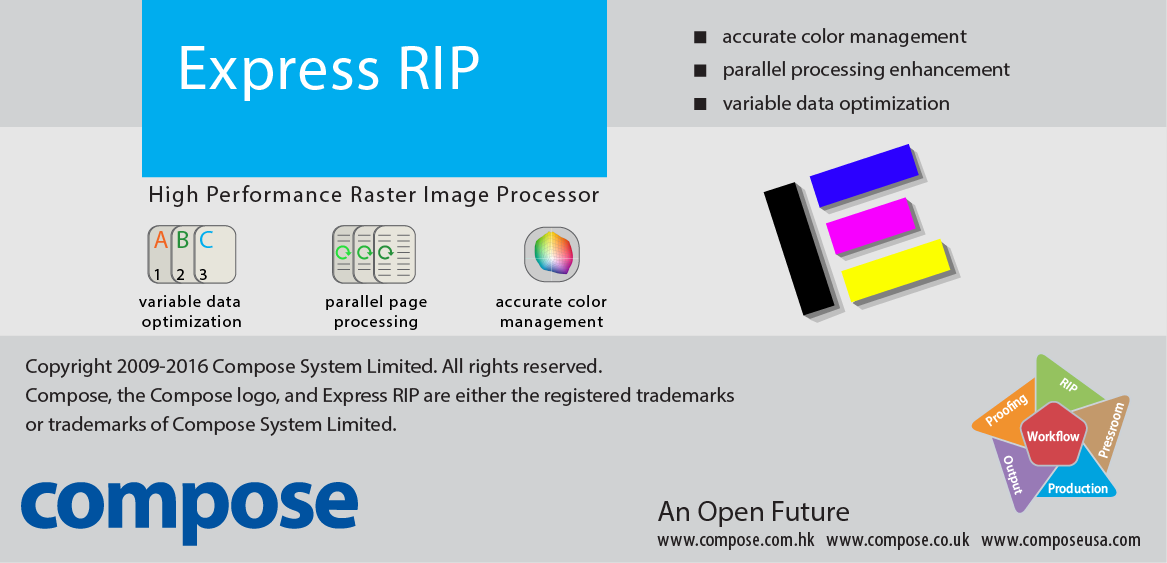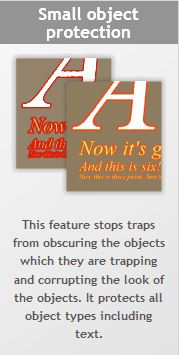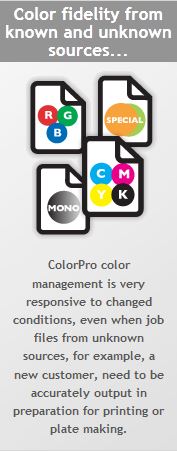

TrapPro ColorPro
Harlequin RIP is reputedly the fastest RIP engine in the market, in recent years it keeps up to date with the hardware market, with improvement such as multi-threaded RIP to make it run even faster, providing benefit in printing variable data and keeping up with the high speed digital printers in the market. It can process Postscript natively making it superfast in handling transparency, and because it can process XPS, it can handle Microsoft document better than anyone else. Today, we like to introduce two key features, TrapPro and ColorPro, which helped us putting a foot in the digital market as we are just better than the competitors.
- TrapPro
- ColorPro

Harlequin TrapPro
The Harlequin TrapPro, object-based raster engine, available with Express RIP, from version 6 onwards. It adds the features demanded by top printers and publishers and is designed to trap jobs automatically. TrapPro in-rip trapping can be easily configured to accommodate different types of job or customer. Trap settings can be saved to reduce system time; improving both quality and consistency of trapped output.

Harlequin TrapPro is an object-based trapping engine that uses the Device-Oriented Display List that is generated in the Express RIP. This allows the trapping engine to trap everything the RIP renders, with pixel accuracy, and with great speed. The traps are drawn with a brush and it maintains color fidelity and traps real device colors so trapping with extra grays is supported.
Harlequin TrapPro provides the following benefits:
Ease-of-use:
An easy to use Graphical User Interface (GUI) allows the user to quickly configure the trapping parameters.
Automation:
Once the user specifies the parameters for trapping, the traps are automatically applied before the file is output to the media.
Preview traps::
After creating a trapset, a user can check that the traps are being generated as intended using the built-in Roam preview feature (or roaming in PPM)
Monitoring in-RIP trapping:
You can use the RIP monitor window to verify that trapping is occurring in the job, and check for quantity of objects trapped and their speed.
Speed:
The trapping itself is much faster than a raster engine; because it does not have to go via an intermediate raster just for the benefit of the trapping engine; the whole workflow is extremely efficient.
Quality:
In generating the traps, TrapPro uses the extra information in the Harlequin Display List which provides a significant advantage over using a pure raster. The traps are clipped to the objects from which they arose, eliminating problems such as mushrooming (normally associated with brush-based traps)
Trapping examples

Anamorphic traps:
Anamorphic trapping is a method of compensating for different degrees of misregistration in the x and y directions in the printing process. Trapping compensates for misregistration, but TrapPro actually compensates for different amounts of possible misregistration in both axes.

Narrowed traps:
There are cases where the full width of the trap does not fit into the available spread area. In these cases, TrapPro automatically modulates the size of the trap to cover a proportion of the available area. The user can adjust the default value. A 50% value is shown in the example below.

Sliding traps:
When adjacent colors have similar neutral densities, TrapPro automatically slides the trap position from spreading the lighter color into the darker color.

Feathered traps:
As an alternative to having a constant color across its width, a feathered trap fades gradually from the full trap color to the background color. The protection against misregistration tails off gradually rather than disappearing abruptly. The visual impact of a feathered trap is generally much less than a constant-color trap of the same size.
Harlequin ColorPro
Harlequin ColorPro, provides excellent color process control and accurate, consistent and predictable color reproduction for a wide range of workflows. Harlequin ColorPro provides full support for industry standard ICC (International Color Consortium) profiles (including device link profiles) avoiding dependence on the generic, system level color management of the computer’s operating system.

ColorPro is the GUI (Graphical User Interface) to the Harlequin RIP kernel where all color managed workflow decisions are setup. This window is feature rich and has evolved to be useable by novice users as well as by operators needing to design complex color managed workflows. Setting up a color managed workflow at the RIP stage is known as late-binding and offers very powerful control over the color management of jobs when the source is known. It is also very controllable even when job files from unknown sources (a new customer for example) need to be accurately output in preparation for printing or plate-making. In addition to the feature set found in Harlequin ColorPro window many additional features can be initiated via PostScript®
In- RIP Color Management:
Decisions about color and output devices can be made late in the production process. With Harlequin ColorPro, a job can be targeted (or re-targeted) to a particular printing process or proofer at the last moment, without requiring any changes in the job itself.
Accurate Color Reproduction on any Device:
Reproducing color across the color gamut of a particular device is handled by Harlequin ColorPro through the use of “rendering intents”, including support for object-based rendering intents.
Customized Color Corrections:
Apply global color corrections (e.g., “warmer”, “brighter”) using the color slider controls when creating custom rendering intents.
ICC Profile Support:
Harlequin ColorPro provides full support of the ICC (International Color Consortium) profile format (through version 4.x of the ICC specification), defined by the International Color Consortium, to allow the installation and use of any profile meeting this industry standard.
Unique “Device-Link” Profile Support:
Harlequin ColorPro delivers full “device-link” profile support for direct CMYK-to-CMYK color transformations, providing the most accurate color possible while delivering an efficient color production workflow.
ColorPro features include:
CMYK and RGB profile support
N color profile support
Grey Profile support
Custom Rendering Intents
Global Color Correction in LAB space
Emulation: Allows for RGB-LAB-CMYK workflows. Based on research and discussions within the ICC body, the future of pre-press workflow will move in part to RGB. This feature will allow an RGB workflow to produce a press accurate proof. Mixed colorspace (RGB/CMYK) page layouts can be accurately proofed as well.
Black threshold control added to Rendering intents – fine tune the black requirements for your proofs to simulate UCR/GCR requirements.
